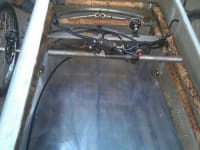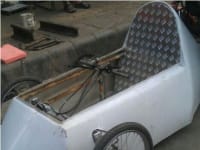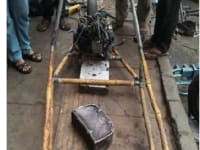As overt from the name “GREEN WARRIOR” of our vehicle, our vehicle design’s prime concern is to ensure that most ecological and biodegradable materials must be put to use for the fabrication. The vivid use of BAMBOO for chassis design is thus incorporated. Bamboo being a material that acts as a carbon sink, conserve biodiversity, beautify the landscape, essentially contributes to the purification and regulation of the environment, produces oxygen and provides organic matter; is the quintessential material for an overall eco- friendly design. Moreover, the carbon emissions are also absorbed by the bamboo which significantly reduces the carbon content released into the environment.
Furthermore, the concern that cutting bamboo can adversely affect environment is insignificant because bamboo is a sustainable, renewable and high yielding forestry crop because it continuously spreads vegetatively. This allows formation of forest much faster compared to most other tree species. Unlike other types of commercial forestry crops where trees must be clear-cut and replanted, in Bamboo plantations only mature stems are harvested whereas younger stems are left untouched to mature and develop.
Also, Bamboo being lighter and stronger than conventional metals significantly increases power to weight ratio, and thus, the mileage.
The reason behind the notion was to come out with something innovative that holds the potential to revolutionize the automobile world and keep up with the rising concerns of the sustainable mobility and ever increasing demands of the fuel with time. Carbon Fiber, being the most booming material in the automotive world, can have a strong competitor as BAMBOO or further efficient researched upon Bamboo composites.
Another objective was to bring out the most efficient and eco-friendly vehicle with the minimum fabrication costs.
The Designing of the chassis with bamboo was the most challenging aspect of the fabrication of vehicle because minute neglect of the strength criterion of the joints would have created a major malaise. The rigorous simulations and analysis on the softwares followed by the physical load analysis and destructive testing of the prototypes on the universal testing machines led us to fabrication of final product.
With due research and experiments, The joints were made with epoxy resin reinforced with the metallic strips bolted on the bamboo and further fitted inside metallic pipe joints with another layer of epoxy resin reinforcing the joints manifold. The shell was further manufactured by light-weight and strong Fiber reinforced plastic (FRP) . It has been designed in Pro/Engineer Wildfire 5.0 with due considerations of aerodynamics, overall profile of the car confirms to the most aerodynamic “inverted teardrop shape” or the aerofoil shape with a self defined NACA number. Drag coefficient of the design is estimated as 0.139 at 40 kmph.
Our vehicle integrates an educational aspect of sustainable mobility by the use of the renewable and sustainable material in significant amount.
Like this entry?
-
About the Entrant
- Name:Shweta Rawat
- Type of entry:teamTeam members:Rashmeet Kaur
Team member - Software used for this entry:Ansys
- Patent status:patented








